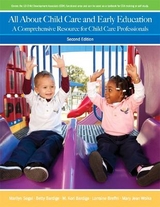
All About Child Care and Early Education
Pearson (Verlag)
978-0-205-45789-2 (ISBN)
- Titel erscheint in neuer Auflage
- Artikel merken
The book provides a brief history of child care and early education and sketches future challenges for the field. It also describes developmentally appropriate indoor and outdoor learning environments and covers the CDA competency areas SAFE, HEALTH, and LEARNING ENVIRONMENT. Broad developmental overviews of infants, toddlers, and preschoolers are included. Each of the CDA competency areas PHYSICAL DEVELOPMENT, COGNITIVE DEVELOPMENT, COMMUNICATION, and CREATIVE is covered in a chapter. Section IV focuses on emotional and social development. It covers the CDA competency areas SELF, SOCIAL, and GUIDANCE. The book explains the behind-the-scenes relationships and practices of adults that generate good outcomes for children. It also includes the CDA functional areas PROGRAM MANAGEMENT, FAMILIES, and PROFESSIONALISM.
Introduction to the Text.
NAEYC Standards for Degree Programs.
Section I: A Child Care Revue.
Changing Perspectives.
History of Child Care and Early Education.
Theories of Child Development and Learning.
Montessori, Gesell, Piaget, Skinner, Erickson, Vygotsky.
Selected Curriculum Models.
High/Scope, Bank Street, Creative Curriculum, Reggio Emilia-Project Approach, Direct Instruction.
Developmentally Appropriate Practices.
Challenges Ahead.
Goals for the Future.
Section II: Setting the Stage.
Introduction: Ensuring a Safe, Healthy, and Appropriate Learning Environment.
Chapter 1: Safety.
Overview, Rationale, and Objectives.
Objective 1: To learn how to plan safe activities by taking into account children’s developmental levels and likely behaviors.
Objective 2: To learn how to create and maintain safe classroom and playground environments.
Objective 3: To review what to do in an emergency.
Objective 4: To learn safe practices for taking children on field trips.
Objective 5: To develop and model good safety habits.
Objective 6: To learn how to involve preschool children in developing safety rules for their classroom.
Objective 7: To learn how to develop a safety curriculum.
Objective 8: To learn how to set up a safe environment for children with special needs.
Chapter 2: Health.
Overview, Rationale, and Objectives.
Objective 1: To develop a sound knowledge base regarding health, nutrition, and oral hygiene.
Objective 2: To carry out routine practices that prevent illness and promote good health and nutrition.
Objective 3: To establish guidelines/policies regarding how to handle health issues, including a record keeping system.
Objective 4: To incorporate activities that teach children and families about health, oral/dental hygiene, and nutrition.
Objective 5: To recognize indicators of abuse and/or neglect and follow the reporting policy mandated by your state.
Objective 6: To keep one's self healthy, and to model appropriate wellness behavior for children and their parents.
Chapter 3: Learning Environments.
Overview, Rationale, and Objectives.
Objective 1: To set up an environment for infants that takes into account the behavioral characteristics and interests of infants at different stages.
Objective 2: To set up an environment that takes into account the behavioral characteristics and interests of younger toddlers.
Objective 3: To set up an environment that takes into account the behavioral characteristics and interests of older toddlers.
Objective 4: To organize and equip preschool classrooms to promote different kinds of play and learning experiences and to reflect the interests, ability levels, and family backgrounds of the children.
Objective 5: To organize and equip a learning environment for a multi-age or family child care setting that includes children birth through five.
Objective 6: To develop well-balanced daily schedules.
Objective 7: To set up an outdoor play and learning environment.
Objective 8: To ensure that the environment works for adults as well as for children.
Section III: On Stage.
Introduction: Advancing Physical and Intellectual Competence.
Chapter 4: Physical.
Overview, Rationale, and Objectives.
Objective 1: To recognize expectable sequences in small and large muscle development in infancy and describe materials and activities that enhance this development.
Objective 2: To recognize expectable sequences in small and large muscle development in young toddlers and describe materials and activities that enhance this development.
Objective 3: To recognize expectable sequences in small and large muscle development in older toddlers and describe materials and activities that enhance this development.
Objective 4: To recognize expectable sequences in small and large muscle development in preschoolers and describe materials and activities that enhance this development.
Objective 5: To identify appropriate activities and to enhance the development of children with special needs.
Chapter 5: Cognitive.
Overview, Rationale, and Objectives.
Objective 1: To recognize expectable sequences in cognitive development in infancy and describe materials and activities that enhance cognitive development.
Objective 2: To recognize expectable sequences in cognitive development in toddlers and describe materials and activities that enhance cognitive development.
Objective 3: To recognize expectable sequences in cognitive development in two to three-year-olds and describe materials and activities that enhance cognitive development.
Objective 4: To recognize expectable sequences in the acquisition of cognitive skills in preschool children and describe materials and activities that support the attainment of sorting, ordering, counting, and pattern identification skills, and conceptual thinking.
Objective 5: To learn how to create a preschool environment that encourages exploration, curiosity and critical thinking.
Objective 6: To learn techniques for introducing meaningful themes into preschool classrooms.
Chapter 6: Communication.
Overview, Rationale, and Objectives.
Objective 1: To recognize the relationship between language development and real world experiences.
Objective 2: To describe the expectable sequence of communication skills in infants and suggest ways to support their development.
Objective 3: To describe the expectable sequence of communication skills in young toddlers and suggest ways to support their development.
Objective 4: To describe the expectable sequence of language skills in older toddlers and suggest ways to support their development.
Objective 5: To describe the expectable sequence of language skills in preschool children and suggest ways to support their development.
Objective 6: To learn ways of reading to children that encourage active participation and engender a love of books.
Objective 7: To provide a description of literacy skills and describe activities that promote these skills.
Objective 8: To describe the small muscle skills that are used in writing and suggest activities that develop these skills and provide the child with opportunities to practice writing.
Objective 9: To select books that foster empathy, promote pro-social behavior, counteract bias, and support bilingualism.
Chapter 7: Creativity.
Overview, Rationale, and Objectives.
Objective 1: To use a variety of teaching techniques to encourage children to think and act creatively.
Objective 2: To recognize ways in which children birth to five express their creativity at each developmental stage and identify caregiver behaviors and techniques that foster the development of creativity.
Objective 3: To describe materials and activities that encourage infants to explore and experiment.
Objective 4: To describe sensory, music, movement, art, building, and pretend play activities that encourage toddlers to express their creativity.
Objective 5: To describe music, movement, art, building, story telling and dramatic play activities that encourage preschool children to express their creativity.
Section IV: The Performers.
Introduction: Supporting Social and Emotional Development and Providing Positive Guidance.
Chapter 8: Self.
Overview, Rationale, and Objectives.
Objective 1: To recognize the sequence of emotional development from birth to five years and the role of the caregiver in supporting this development.
Objective 2: To recognize ways in which infants develop trust and a sense of security.
Objective 3: To describe ways in which young toddlers develop self-awareness and learn to cope with separation.
Objective 4: To describe ways in which older toddlers/two-year-olds develop a sense of autonomy.
Objective 5: To recognize ways in which caregivers can help preschool children develop a sense of personal identity and self worth and feel good about their heritage.
Objective 6: To describe ways in which caregivers can help young children develop a sense of responsibility.
Objective 7: To describe ways in which teachers can create an inclusive classroom where every child is welcome.
Chapter 9: Social.
Overview, Rationale, and Objectives.
Objective 1: To recognize the sequence of social skill development from birth to five years and the role of the caregiver in supporting this development.
Objective 2: To recognize ways in which infants and toddlers develop meaningful relationships with parents, caregivers, other adults, peers, and older children.
Objective 3: To recognize ways of encouraging preschool children to make friends and engage in social play.
Objective 4: To help children build on their strengths and overcome difficulties.
Objective 5: To describe ways in which caregivers can encourage respect, empathy, helping, sharing and caring.
Objective 6: To design a classroom environment and curriculum that supports cooperative behavior.
Chapter 10: Guidance.
Overview, Rationale, and Objectives.
Objective 1: To identify ways of helping infants achieve self-regulation and develop coping skills.
Objective 2: To identify ways of helping young toddlers explore their world and make new discoveries without being destructive or wasteful and without causing injury to themselves or others.
Objective 3: To help older toddlers cope with fear, anger and frustration and strike a balance between a longing for nurturance and a desire to be independent.
Objective 4: To learn ways of helping preschool children recognize and value differences, resolve conflicts, express their feelings in words, and accept reasonable limits.
Objective 5: To recognize ways of using positive guidance techniques to reduce unwanted behaviors.
Objective 6: To recognize ways of providing positive guidance for children whose families use styles of discipline that are different from those you have been taught.
Objective 7: To learn ways of responding to challenging behaviors.
Section V: Behind the Scenes.
Introduction: Working as a Professional with Families and in Child Care Programs.
Chapter 11: Families.
Overview, Rationale, and Objectives.
Objective 1: To understand the many purposes of establishing good communication with parents.
Objective 2: To learn how to set up a parent-school partnership.
Objective 3: To learn strategies for keeping parents informed about center activities and to encourage participation in parent meetings and volunteer opportunities.
Objective 4: To learn strategies for serving as a resource for families and building a community that supports families.
Objective 5: To learn strategies for engaging parents in decision-making and advocacy.
Chapter 12: Program Management.
Overview, Rationale, and Objectives.
Objective 1: To work cooperatively as a member of a team.
Objective 2: To follow the policies and procedures set down by the center.
Objective 3: To maintain a record keeping system that serves as the basis of individual and group program planning.
Objective 4: To manage your own classroom efficiently so that you devote most of your time to working directly with the children.
Chapter 13: Professionalism.
Overview, Rationale, and Objectives.
Objective 1: To seek opportunities to increase professional knowledge and improve professional skills.
Objective 2: To serve as an advocate for children and families.
Objective 3: To maintain the ethics of the early childhood profession.
Objective 4: To build a professional support system.
| Erscheint lt. Verlag | 12.1.2006 |
|---|---|
| Sprache | englisch |
| Maße | 216 x 276 mm |
| Gewicht | 735 g |
| Themenwelt | Kinder- / Jugendbuch ► Sachbücher ► Körper / Sexualität |
| Sozialwissenschaften ► Pädagogik ► Berufspädagogik | |
| Sozialwissenschaften ► Pädagogik ► Schulpädagogik / Grundschule | |
| Sozialwissenschaften ► Pädagogik ► Vorschulpädagogik | |
| ISBN-10 | 0-205-45789-4 / 0205457894 |
| ISBN-13 | 978-0-205-45789-2 / 9780205457892 |
| Zustand | Neuware |
| Informationen gemäß Produktsicherheitsverordnung (GPSR) | |
| Haben Sie eine Frage zum Produkt? |
aus dem Bereich



